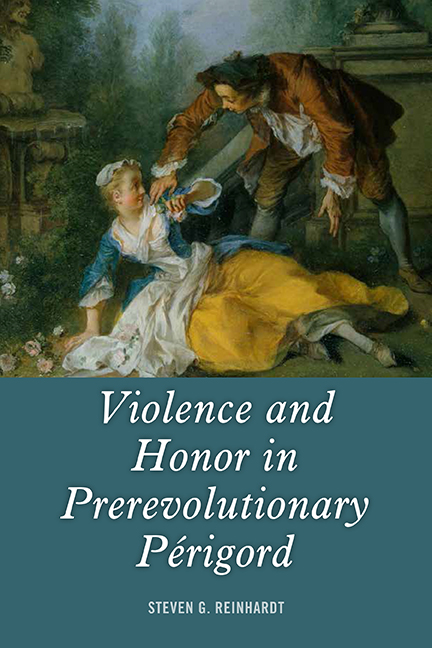Book contents
- Frontmatter
- Dedication
- Contents
- Acknowledgments
- Maps
- Introduction: “The Saint of Honor”
- 1 Violence and Honor
- 2 Honor in a Cross-Cultural Context
- 3 From Honor to Honnêteté in Old Regime Europe
- 4 “The Good Old Days” in Prerevolutionary Sarladais
- 5 “The Saint of Honor” in the Sénéchaussée of Sarlat
- 6 Women and Honor-Related Criminal Affaires
- 7 Policing Honnêteté: Shameful, Sinful, and Criminal Conduct
- 8 “Fallen Women” and Infanticide
- 9 Compromised Honor and Dangerous Liaisons
- 10 Honor and Homicide
- Conclusion
- Notes
- Bibliography
- Index
2 - Honor in a Cross-Cultural Context
Published online by Cambridge University Press: 10 June 2021
- Frontmatter
- Dedication
- Contents
- Acknowledgments
- Maps
- Introduction: “The Saint of Honor”
- 1 Violence and Honor
- 2 Honor in a Cross-Cultural Context
- 3 From Honor to Honnêteté in Old Regime Europe
- 4 “The Good Old Days” in Prerevolutionary Sarladais
- 5 “The Saint of Honor” in the Sénéchaussée of Sarlat
- 6 Women and Honor-Related Criminal Affaires
- 7 Policing Honnêteté: Shameful, Sinful, and Criminal Conduct
- 8 “Fallen Women” and Infanticide
- 9 Compromised Honor and Dangerous Liaisons
- 10 Honor and Homicide
- Conclusion
- Notes
- Bibliography
- Index
Summary
Observers from modern Western societies in which law and order prevail and the state monopolizes the use of legitimate coercion often misunderstand the role of violence in traditional societies, both current and past. They still tend to see them as incessantly torn by feuds, as “backward” places where lawlessness—indeed, anarchy—prevails, where people fend for themselves in a war of all against all. Limiting one's focus solely to violence and honor in past European societies without viewing them in a cross-cultural context can exacerbate this misunderstanding. Examining the intersection of violence and honor from the wider perspective of cultural anthropology, however, enables historians to gain insight into related behaviors in comparable societies. In the past four decades, Western scholars (including two generations of early modern French historians) have come to appreciate not only that the inhabitants of past (and current) kinordered societies with codes of honor follow culturally prescribed customary rules that govern social relations, but also that such societies maintain relative harmony precisely through reliance on proportionate violence and the threat (or actuality) of the blood feud. Most notably, Mark S. Weiner examines how kin-ordered societies—those that Henry Sumner Maine termed societies of “status” because the relative status of its members depends on their position within the extended family or clan—can be highly effective in disciplining their members and thereby achieve a “rough peace among kin groups.”
The clan's collective interest in guarding its honor exerts powerful pressure on members to conform to their designated roles, restrain their personal behavior, and minimize or settle their disputes informally. But the anti-individualist ethos of kin-ordered societies tends to limit personal freedom, particularly that of women, who theoretically are confined to the traditional role of childbearers to preserve the clan.
Scholars who have read the proscriptions of early modern moralists and playwrights have been inclined to view women—especially those of Mediterranean Europe—as having led lives of seclusion, sexual fidelity, and subjection. They have even repeated the trope used by contemporary moralists that a woman's body was analogous to the walls of a house that had to remain intact.
- Type
- Chapter
- Information
- Violence and Honor in Prerevolutionary Périgord , pp. 26 - 45Publisher: Boydell & BrewerPrint publication year: 2018

